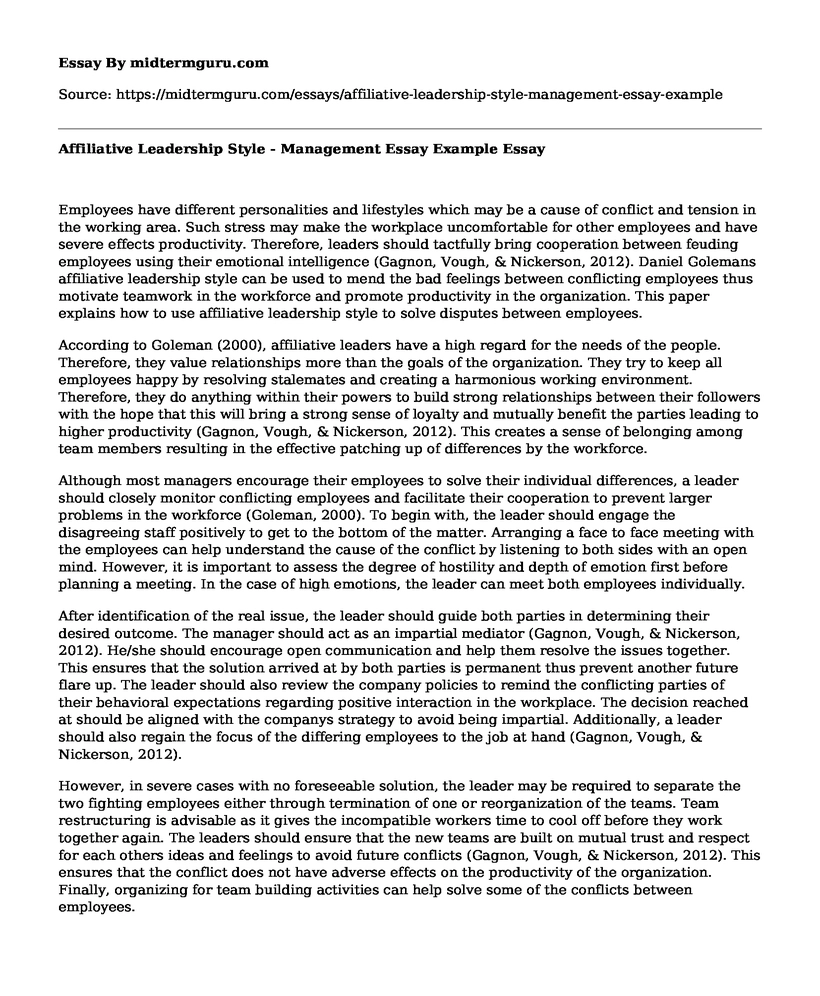Employees have different personalities and lifestyles which may be a cause of conflict and tension in the working area. Such stress may make the workplace uncomfortable for other employees and have severe effects productivity. Therefore, leaders should tactfully bring cooperation between feuding employees using their emotional intelligence (Gagnon, Vough, & Nickerson, 2012). Daniel Golemans affiliative leadership style can be used to mend the bad feelings between conflicting employees thus motivate teamwork in the workforce and promote productivity in the organization. This paper explains how to use affiliative leadership style to solve disputes between employees.
According to Goleman (2000), affiliative leaders have a high regard for the needs of the people. Therefore, they value relationships more than the goals of the organization. They try to keep all employees happy by resolving stalemates and creating a harmonious working environment. Therefore, they do anything within their powers to build strong relationships between their followers with the hope that this will bring a strong sense of loyalty and mutually benefit the parties leading to higher productivity (Gagnon, Vough, & Nickerson, 2012). This creates a sense of belonging among team members resulting in the effective patching up of differences by the workforce.
Although most managers encourage their employees to solve their individual differences, a leader should closely monitor conflicting employees and facilitate their cooperation to prevent larger problems in the workforce (Goleman, 2000). To begin with, the leader should engage the disagreeing staff positively to get to the bottom of the matter. Arranging a face to face meeting with the employees can help understand the cause of the conflict by listening to both sides with an open mind. However, it is important to assess the degree of hostility and depth of emotion first before planning a meeting. In the case of high emotions, the leader can meet both employees individually.
After identification of the real issue, the leader should guide both parties in determining their desired outcome. The manager should act as an impartial mediator (Gagnon, Vough, & Nickerson, 2012). He/she should encourage open communication and help them resolve the issues together. This ensures that the solution arrived at by both parties is permanent thus prevent another future flare up. The leader should also review the company policies to remind the conflicting parties of their behavioral expectations regarding positive interaction in the workplace. The decision reached at should be aligned with the companys strategy to avoid being impartial. Additionally, a leader should also regain the focus of the differing employees to the job at hand (Gagnon, Vough, & Nickerson, 2012).
However, in severe cases with no foreseeable solution, the leader may be required to separate the two fighting employees either through termination of one or reorganization of the teams. Team restructuring is advisable as it gives the incompatible workers time to cool off before they work together again. The leaders should ensure that the new teams are built on mutual trust and respect for each others ideas and feelings to avoid future conflicts (Gagnon, Vough, & Nickerson, 2012). This ensures that the conflict does not have adverse effects on the productivity of the organization. Finally, organizing for team building activities can help solve some of the conflicts between employees.
In conclusion, employee conflicts can be a major disrupter of productivity in an organization. They can create a toxic work environment for other workers. Therefore, it is important for leaders to confront conflicts among employees to prevent deterioration of the workplace into an overly disruptive chaos. However, managing conflicts can be tricky thus requires a leader to have emotional intelligence. The application of affiliative leadership style can help managers to solve fights between co-workers. The affiliative leadership style nurtures workplace relationships and promotes open communication between workers to enable them to solve conflicts harmoniously.
References
Gagnon, S., Vough, H., & Nickerson, R. (2012). Learning to Lead, Unscripted. Human Resource Development Review, 11(3), 299-325. http://dx.doi.org/10.1177/1534484312440566
Goleman, D. (2000). Leadership That Gets Results. Harvard Business Review. Retrieved 3 February 2017, from https://hbr.org/2000/03/leadership-that-gets-results
Cite this page
Affiliative Leadership Style - Management Essay Example. (2021, Jun 01). Retrieved from https://midtermguru.com/essays/affiliative-leadership-style-management-essay-example
If you are the original author of this essay and no longer wish to have it published on the midtermguru.com website, please click below to request its removal:
- Brief Overview of Mckinsey 7s Framework Paper Example
- Discussion Questions on Healthcare Leadership Paper Example
- Science and Thinking Systems for Public Health: A Systematic Review of the Field - Paper Example
- Essay Sample on Affirmative Action Planning
- Motivating Employees: An Essential Management Responsibility - Essay Sample
- How Has the Role of the Strategic Planner Changed Over the Past Few Decades? - Essay Sample
- Leadership Qualities: The Key to Success in Any Organization - Essay Sample







